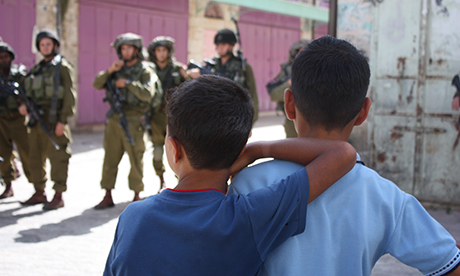Open letter from Hebron
The Old City of Hebron used to be a bustling market place, full of stalls selling fruit, meat and other sundries. Today, it stands as a shadow of its former self. When I walked down the main road this morning, the shops were all boarded up, and the only signs of life were the bored-looking soldiers standing guard at the military checkpoints. I am currently serving as a human rights monitor for the Ecumenical Accompaniment Programme in Israel and Palestine (EAPPI) in the West Bank, which is part of Palestine and is under the occupation of the Israeli military.
Many of you will have been watching with horror the suffering of the Palestinians in Gaza over the last two weeks. According to the latest UN figures, over 1,400 people have been killed since the beginning of Operation Protective Edge. Most of those killed have been civilians, including 252 children, whilst over 4,000 people have been injured. Gaza is part of occupied Palestine and is home to 1.8 million Palestinians – but just 40km away lies Hebron, in the other (geographically separate) part of occupied Palestine.
The West Bank has been occupied by Israel since 1967. This small portion of land that runs alongside the banks of the River Jordan is home to 2.5 million Palestinians and 500,000 Israelis. It is a volatile place, but, for the most part, life goes on – albeit with the possibility of violence never too far away. There are also innumerable challenges for Palestinians livings in the West Bank: they are often denied their basic human rights. That is why I am here – to observe, monitor and report on the human rights violations that are commonplace in the occupied Palestinian territories.
I am working in Hebron, the largest city in the West Bank. The heart of the city is home to around 30,000 Palestinians and around 800 Israeli settlers – and relationships between the two communities are perhaps more strained here than anywhere else – Hebron is of great religious significance to both Israelis and Palestinians because it is home to the Ibrahimi Mosque (also known as the ‘Cave of the Patriarchs’) which is the fourth holiest site for Muslims and the second holiest for Jews. This makes it flashpoint for
intercommunity violence.
My job as a human rights monitor is varied. We get up very early in the morning and walk alongside Palestinian children on their way to school. We do this because they often face violence and intimidation from Israeli settlers and the Israeli army. By being present, we hope to reduce the likelihood of violence, and also to document any incidents that do occur. The information we collect is used for advocacy purposes: the information is passed to NGOs (Israeli, Palestinian and international) and foreign governments.
There are often violent clashes in Hebron – these usually follow prayers on a Friday, but recently, in light of the tension in Gaza, they have been breaking out more frequently. It’s hard to imagine the things I see on a daily basis taking place on Mare Street or the Kingsland Road. When I return to Hackney later in the year, I know I’ll be grateful for the fact that my daily cycle to Old Street from Clapton will be free of military checkpoints.
Being here in Palestine, I have also realised how powerful individuals can be in countries like the UK. We can all do something about what is happening here. It is important that human rights monitors are here on the ground, but it is perhaps more important that the information we collect is used back home to inform the public, the media and government about what is happening.

